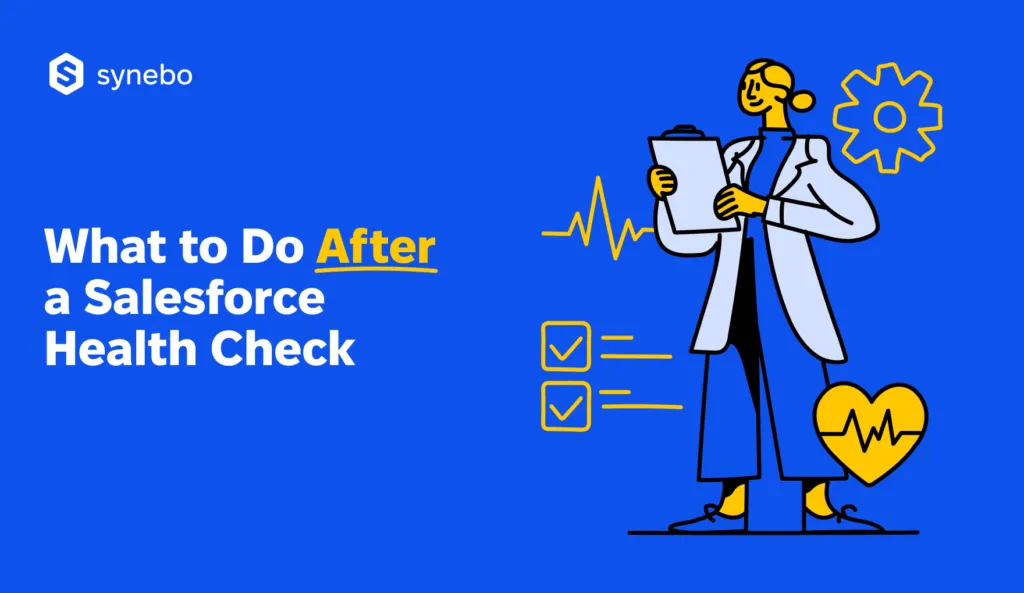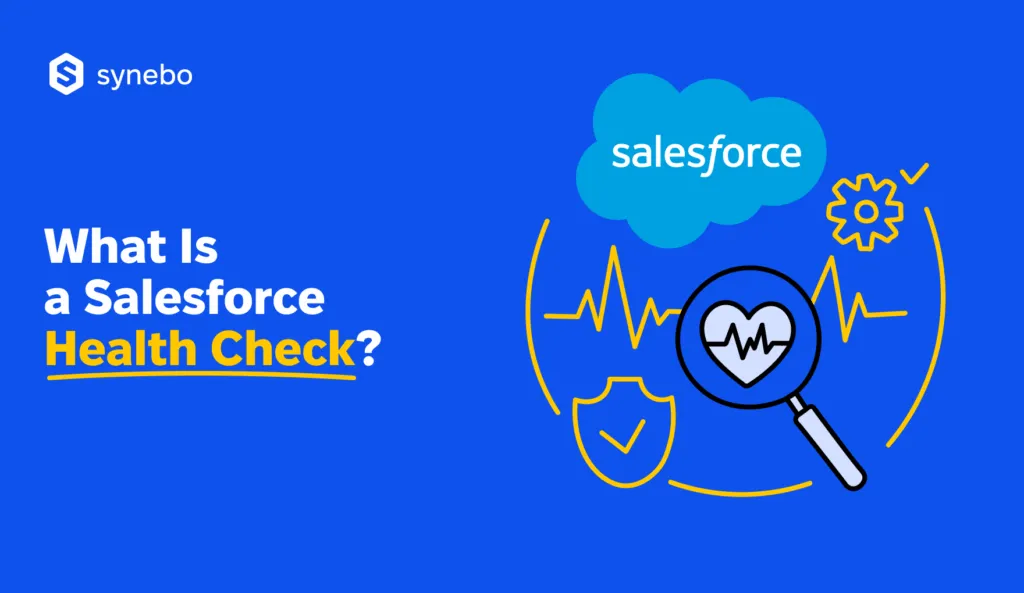How to Run a Salesforce Health Check
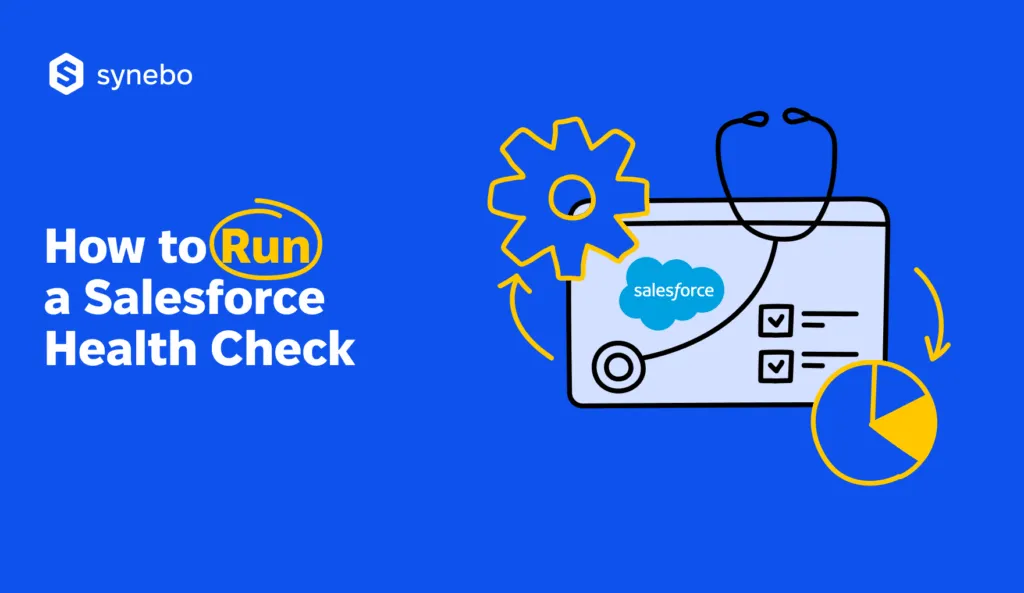
The article was updated on August 26, 2025.
Even when your Salesforce org appears to be working quite well, some lurking missteps like over-broad permissions or unchecked guest access open security holes and slow workflows. And the trick is that nobody notices it.
A Salesforce Health Check shines light on such hidden cracks. It flags risky protection settings, inefficient automations, and compliance gaps. This helps your admins, security team, and your business leaders see where exactly your system falters and why. Your admins gain clarity, and security teams get insights they can follow. Your company’s key leaders gain confidence that their CRM isn’t quietly bleeding value.
In the next sections, we’ll guide you how to run a health check in Salesforce that unearths silent flaws, fixes them before anyone detects a problem and keeps your Salesforce org reliable, and trusted.
Hidden Costs of Ignoring Salesforce Health Checks
SF exists to speed up your growth. Its entire design and evolution follow that principle. The platform is not supposed to feel like a puzzle missing key pieces. Yet, many businesses discover – sometimes too late – that their CRM quietly leaks revenue through poor data hygiene, awkward processes, or unused features.
Many years of our experience prove that а neglected SF setup can silently drain a company’s resources, frustrate its crews, and block decision-makers from seeing the whole picture in full.
A health check in Salesforce functions like a sharp lens. It scrutinizes your system and reveals blind spots that otherwise stay hidden.
Why it matters:
- Data tells stories (or lies). Inaccurate or duplicate records distort forecasts and damage your customer trust. Regular audits ensure that the numbers you rely on are trustworthy.
- Processes shape momentum. We can confirm that over-engineered workflows slow down many cycles and processes. Your Salesforce org assessment trims any clutter, and it always results in letting your team move faster with processes and decisions.
- Costs sneak in unnoticeably. Unused licenses, redundant apps, or problematic automations inflate your expenses. When you identify and address that waste, you keep your budget lean.
- Your successful strategy needs the truth. All your executives base their decisions on CRM insights. If this foundation is shaky, even the smartest-looking strategy risks collapse.
A Salesforce system health check works as preventive care. Instead of firefighting issues after they spiral, you gain confidence that your СRМ truly supports your growth without hidden leaks.
Read Also: What Is a Salesforce Health Check and Why Your Org Needs One?
Perfect Moments for Running a Salesforce Health Check
If you notice your sales crew stops logging data, dashboards look suspiciously off, and/or your customer records resemble a patchwork quilt, it’s not always people who are at fault. More often, the system itself needs attention.
When you know the right moment for performing a Salesforce health check, you save yourself time and stress, because you keep your system in a condition that consistently supports your growth.
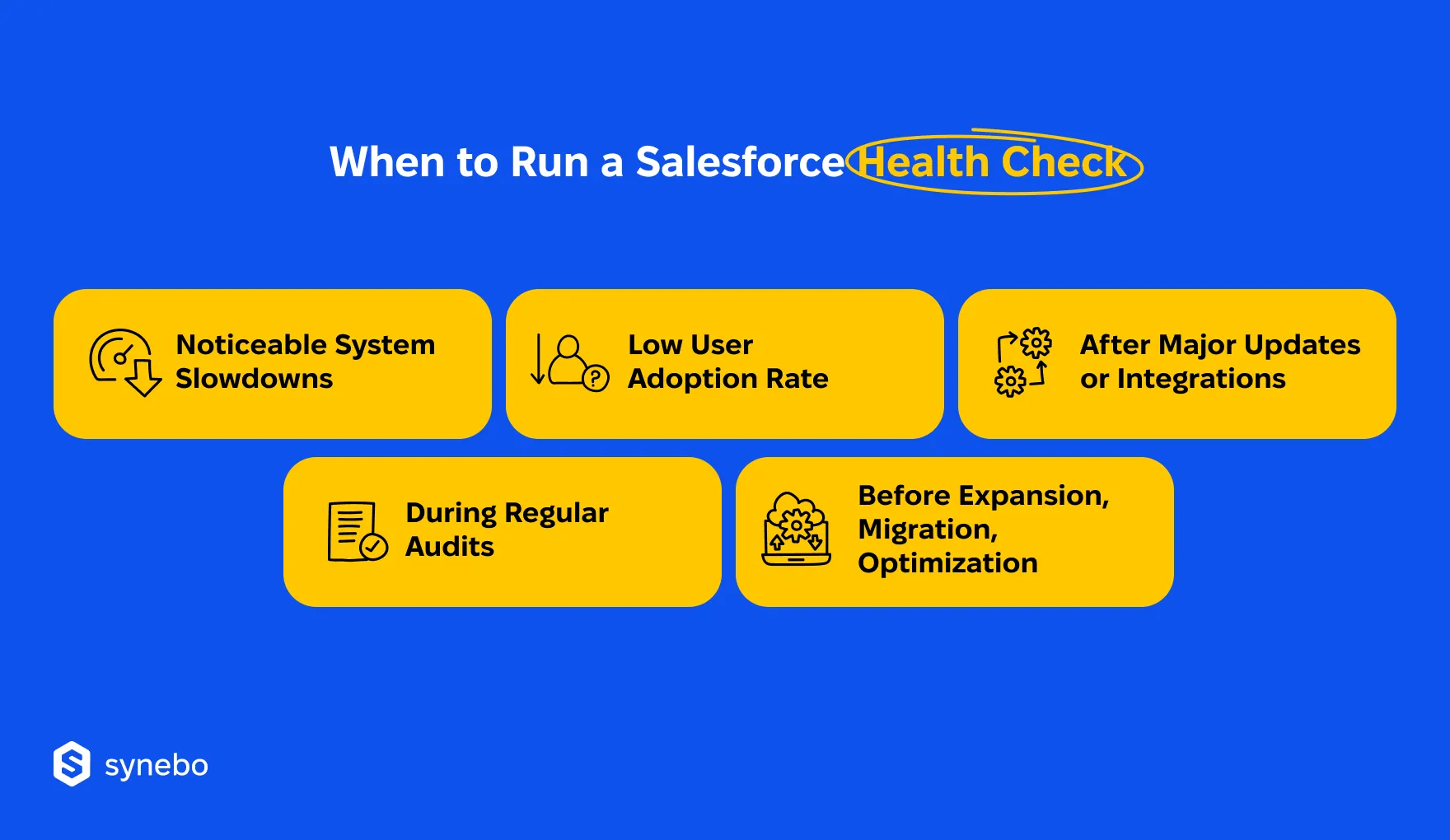
So, these are the signals you shouldn’t ignore:
- You see/feel that performance dips. If reports take too long to load, workflows stall, or automations stutter, it’s surely time for a diagnostic. Slow systems cost you both time and trust in the system.
- Your setup was recently updated or integrated with other systems. New features or 3d-party tools often create hidden clashes. Running a review right after these ensures your CRM remains stable and secure.
- You schedule regular audits. Treating SF like your finances is a good approach (the same way as you wouldn’t skip quarterly or annual reviews of your books). Scheduled Salesforce health checks give you a baseline and highlight inefficiencies.
- You plan expansion, migration, or optimization projects. Scaling a shaky system only multiplies problems. Such an assessment clears your foundation before you add further complexity.
In a nutshell, a proactive approach/timing is essential. It makes Salesforce a reliable driver of your results.
Doubting? Hesitating? Never done any audit before on your own? Book a Salesforce health check with Synebo the moment you notice issues with performance, adoption, or following recent updates. Our team will pinpoint the problem and keep your SF reliably supporting your growth.
Prep Steps for a Salesforce Health Check Assessment
A professional health audit can be stalled by missing access, outdated data, or unclear priorities. We would compare it with inviting a mechanic to service your car: if you forget the keys, progress halts.
So, to be sure your Salesforce org health check delivers real insights (rather than surface-level observations), we recommend preparing properly.
What you should have ready:
- Access and permissions. Make sure that the right people – consultants, auditors, or internal admins – can reach every corner of your org. Limited access/visibility leads to incomplete analysis.
- Backup your org. Even though a Salesforce org health assessment rarely alters live data, still safeguard your environment. A fresh backup guarantees your peace of mind in case unexpected issues surface.
- Identify business-critical areas. Sales forecasting, customer data, automation flows – what matters most to your organization? If you highlight these priorities, you’ll direct the assessment toward what impacts results instead of wasting effort on trivial features.
- Prepare to document findings. Insights vanish quickly if left in conversation – and it’s a typical situation. So, set up a structured way to capture notes, outcomes, and recommendations. The knowledge has to remain actionable after the session.
- Collect feedback from users. Your employees can often sense friction points before your C-level executives do. Their voices can help shape a fuller picture and prevent recurring pain from being overlooked.
As a final note, we’d say that solid preparation turns a Salesforce org health-check assessment into a catalyst for stronger performance.
What a Salesforce Health Check Examines
So, which areas does a Salesforce health check review? Basically, it inspects the critical zones where your CRM often hides inefficiencies, vulnerabilities, and issues.
- Security. Are permissions too loose and they can expose sensitive data? Or too tight (so they limit efficiency)? Who has access to which records? A focused Salesforce security health check sроts users with excessive permissions, roles that overlap, and any potential vulnerabilities in your org. Plus, it reviews API versions to ensure your org isn’t relying on outdated, potentially risky configs.
- Storage usage. Salesforce isn’t bottomless. A health check in Salesforce assesses how much space your data, files, and attachments consume, and if you’re inching toward critical limits that can slow down your org.
- Objects and fields. Every extra field or object adds weight. We review the number you’ve got, how close they are to Salesforce limits, and where optimization might save you headaches down the road.
- User licenses. Are you paying for more than you need? Or stretching too few across too many people? A Salesforce health check audit shows you exactly how your licenses are being used – and whether you’re getting maximum value.
- Automation overlaps. Multiple processes firing on the same object can create unexpected lagging or outright malfunctions. A health check digs into your flows, workflows, and process builders and pinpoints risky overlaps.
- Code quality. Custom code is powerful – but only when it’s clean. The audit reviews your Арех and triggers for efficiency, maintainability, and best practices, and gives clear suggestions for improvements.
A Salesforce health check is a comprehensive diagnostic. It shines light on weak spots. It uncovers risks in security, usage, and architecture, then hands you insights you can implement to keep your org leaner, safer, and sharper. Ready to scale with you.
How to Perform a Salesforce Health Check
When executives lose faith in SF data, the problem is rarely in a single field or report. It’s often deeper. A health scan digs into those layers.
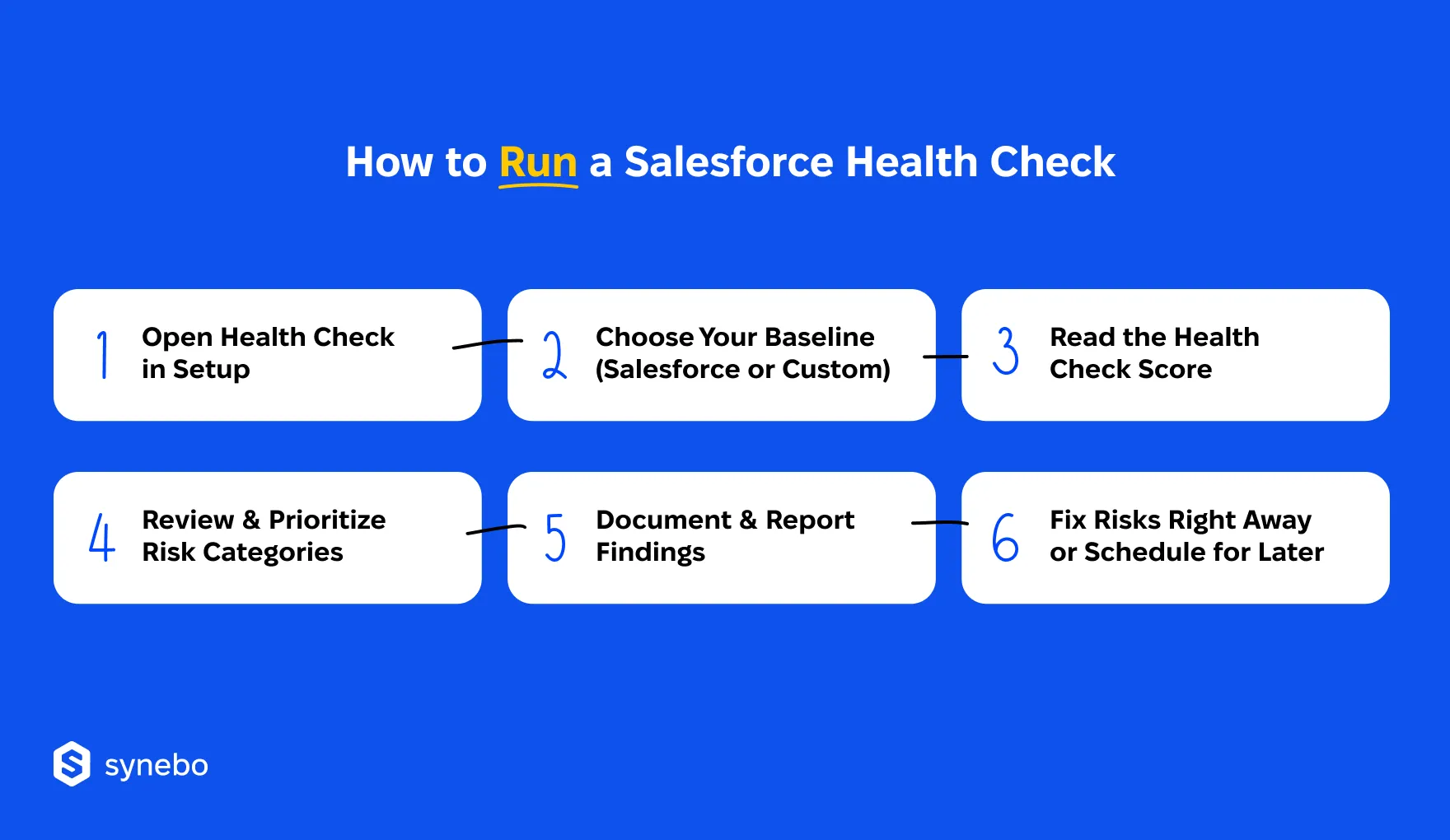
So, how to perform a Salesforce health check to get trustworthy results?
- Go to the Health Check in Setup. Start by accessing Setup → Health Check. This native SF tool offers an overview of your org’s security posture. It’s your entry point.
- Choose your benchmark. SF provides a standard baseline, but many companies design a custom one to reflect industry or company-specific policies. Decide which baseline you’ll stick to, because it shapes how you classify risks.
- Decode the Salesforce health check score. High score means stronger safeguards, medium one signals moderate gaps, and Іow – warns you of vulnerabilities.
- Rank the risks. Not every issue you see in the report deserves urgency. High-risk gaps indeed ask for your attention. Medium risks are OK to be planned for upcoming optimizations. Low risks may remain on your radar for later.
- Document and report findings. Use reports, screenshots, or structured notes to document the assessment. It becomes a foundation for audits and compliance reviews.
- Decide if you’ll fix issues now or later. Some risks (for example, overly broad admin permissions) need to be fixed on the spot. Others (like outdated раssword роlісіеs) – you can schedule together with broader sys improvements.
To gain trustworthy diagnostics results, we recommend pairing Salesforce Health Check with tools like Security Center and Optimizer. These scans well surface inefficiencies and unused features, yet – please note – they can’t weigh your business priorities or contextual nuances.
That’s why a thoughtful human review remains essential.
An experienced Salesforce specialist can interpret the findings, prioritize your next actions, and translate raw insights into improvements that meet your company’s strategy. Seeking such a consultant? Contact Synebo.
How Synebo Approaches a Comprehensive Health Check
What makes a Salesforce Health Check truly valuable is knowing how to read between the lines. Our Salesforce specialists go beyond the default score. We uncover non-obvious risks, fine-tune configs, and from the recommendations the system gives, we create a plan for your org improvements.
So, how do we approach a Salesforce health сheck that keeps your SF environments secure and ready for growth? Here are our vital steps.
Step 1: Discovery + Alignment
To first capture your business goals, current points of pain, and critical focus areas, we begin with a guided conversation. This step in our Salesforce health check services is essential because the audit can’t wander aimlessly. It must stay aligned with your objectives.
Step 2: Automated Scanning + Мanual Review
We use a combo of tool-based analysis and our expert inspection and check permissions, integrity of data, overall performance of your system, all the integrations you have, and any components that add no real value but still weigh your org down.
(This hybrid approach to the Salesforce health issues allows us to identify both technical problems and those that are visible only in the practice of using the system.)
Step 3: Prioritization + Transparency
We then categorize risks the audit finds by their severity. As a result, you get an understanding which issues need quick reaction and which ones are OK to schedule for improvements in the future. Such clarity helps you align on priorities. It also helps plan your resources efficiently.
Step 4: Reporting + Roadmap
We document every finding, plus we support it with explanations, consult on potential consequences, and give уоu further recommendations. Instead of vague advice, you receive a рlan with needed actions and timelines. It helps you confidently move from problem recognition to execution.
Step 5: Implementation Support
Usually, Synebo either partners with the client team to fix critical Salesforce health issues or provides precise guidance for in-house execution. In both cases, you’re certain that your system risks are addressed, and the system itself is set for future scaling.
A Salesforce health check and optimization with Synebo is more than a technical audit. It’s a disciplined process that turns SF into a platform your business can rely on for security and growth.
Where Confidence in Salesforce Begins
When you start questioning if SF data is OK and you can trust it, hesitation usually spreads quickly, from sales forecasts to boardroom decisions. That is the true cost of neglecting system health. A structured – and regular – health check for Salesforce prevents that spiral. It replaces doubt with control and confidence.
At Synebo, we specialize in conducting Salesforce health checks that dig deeper than surface-level metrics. Our process uncovers risks, eliminates clutter, and highlights opportunities that strengthen performance in your entire org.
Performance or adoption slipping, reports running slow, or expansion on the horizon – the best time to take control of your SF is now. Connect with Synebo, and let’s make your Salesforce quick, reliable, and ready to power every business decision you make.
A Salesforce Health Check is a tool within Salesforce that evaluates the security settings of your Salesforce environment against a baseline of best practices. It helps identify potential vulnerabilities and provides recommendations for improvement.
Using Health Check during app development is crucial for ensuring that the app’s security settings align with best practices. It helps in identifying and mitigating security risks early in the development process, leading to a more secure application.
The time it takes to run a Salesforce Health Check can vary based on the complexity and size of your Salesforce org. Typically, it’s a quick process that can take just a few minutes to complete.
Salesforce provides built-in tools for health checks, including the Salesforce Security Health Check and Salesforce Optimizer. These tools help evaluate your org’s settings and provide recommendations for improvement.
Conducting a Salesforce Health Check is important for maintaining the security and performance of your Salesforce org. It helps identify potential vulnerabilities and areas for improvement, ensuring that your org complies with best practices.
Salesforce Health Check works by comparing your org’s security settings against a set of best practice standards. It provides a score based on how closely your settings match these standards and offers recommendations for improving your security posture.


